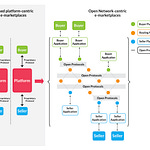Antariksh Matters #1: Spying on Spy Satellites
— Pranav R Satyanath
In February this year, the United States launched a nondescript satellite simply designated as NROL-87. Those who keep a close of space launches know that the NROL designation stands for national security satellites operated by the National Reconnaissance Office. The satellite likely entered a 284 x 425 km Sub-synchronous orbit with an inclination of 97.25 degrees. The NROL-87, also designated as USA 326, is suspected to be a new generation of electro-optical imaging satellite. This spy satellite, one among many operated by the US, kept to itself with nothing to bother its mission. Until now.
Earlier this month, Russia launched a nondescript satellite on board a Soyuz-2.1V from the Plesetsk launch site. The secret satellite, Kosmo-2558, was launched just as NROL-87 passed above the Russian launch complex. Space watchers like Jonathan McDowell quickly predicted that Kosmos-2558 would likely reach the planar orbit of NROL-87 within 80 km of the American spy satellite’s range. The orbital behaviour of the Kosmos-2558 resembles that of an ‘inspector satellite’, which, in other words, means that Russia launched a satellite to spy on another satellite.
Of course, the presence of inspector satellites in space is not a new phenomenon. Classified under the category of Rendezvous and Proximity Operations (RPO), satellites have been launched to either inspect or potentially attack other satellites in the past. Not all RPO satellites have malign intentions. For example, in the 1990s, Canada proposed using inspector satellites to verify arms control agreements in outer space.
More recently, however, RPOs have been viewed with suspicion. The sharp increase in the number of satellites being placed in orbit has made it all the more difficult to predict the purpose of satellites which may or may not have military utility. Since countries do not disclose details of the satellites they launch, the lack of transparency does little to decrease uncertainties.
Policymakers and policy analysts have considered several possible solutions to the problem of transparency. Some scholars propose a pre-launch notification mechanism under which countries not only notify others of the launches of rockets and ballistic missiles that are set to take place but also provide details about the nature of the launch vehicle or ballistic missile.
Pre-launch notification agreements concerning ballistic missiles have been signed in bilateral settings in the past. The United States and Russia signed such an agreement in 1988. India and Pakistan signed a similar agreement in 2005. No attempt has been made to craft similar agreements for space launch vehicles. One reason might be that providing pre-launch notifications might be because countries fear that adversary countries might take countermeasures against potential spy satellites. Such concerns were expressed as far back as 1958, as seen in the memorandum from the Arms Control and Disarmament Agency (ACDA) to the President of the United States.
Another solution that has been proposed to avoid the risk of RPOs is to implement a keep-out zone for satellites. While such an agreement does not require a verification mechanism, countries could choose to use space situational awareness (SSA) capabilities to enforce a keep-out zone agreement. SSA capabilities have their limitations as no single national system can currently provide full coverage of Low-earth orbit (LEO) and geosynchronous Earth orbit (GEO). Establishing a global SSA network is also challenging and expensive.
Although RPOs have not been a problem till date, they may become a problem in the future. Analysts have already begun to take notice of the increase in RPOs in recent years. If countries wish to mitigate the risks associated with RPOs, they must start preliminary negotiations sooner rather than later.
(The author would like to thank Aaron Bateman for providing access to declassified documents related to the US space progaramme.)
Antariksh Matters #2: The Indian Army’s ‘Skylight’ Exercise
— Aditya Ramanathan
It would be unusual for readers of this newsletter to find an entry describing an exercise conducted by the Indian Army. However, there was much about the recently concluded Exercise Skylight that was unusual, and that warranted an entry in Technopolitik.
What little is known about the exercise comes from scant official information and a few news stories. The Army’s official Twitter handle described it as a satellite communication exercise. It went on to add:
“100% satellite communication assets were activated to ensure operational readiness of hi-tech satellite systems and exercise various contingencies.”
The tweet would indicate Exercise Skylight tested all of the Army’s orbital communications (which are scattered across multiple satellites) and that these systems were tested for ‘contingencies’. What might be these contingencies? ThePrint cited an anonymous source who indicated the Army wanted to validate its ability to use space-based communications as a redundancy during wartime:
“Conflict situations demand space-based communication because we are going by the assumption that the primary means of communication — terrestrial media — gets disrupted”.
Of course, the Army understands the vital advantages space-based communications provide. This is especially evident in the Himalayas along the Line of Actual Control (LaC) with China, where satellites can enable tactical communication well beyond the line-of-sight.
The Russia-Ukraine war also seems to loom over Exercise Skylight. The Times of India cited an anonymous source as saying the Army was carefully following the use of cyber and electronic warfare in that conflict. In particular, the Army appears to be impressed by the resilience of the SpaceX Starlink satellite internet constellation, which Ukrainian forces have been using to coordinate operations against Russia. In the coming years, the Army is expected to look to acquire easily portable satellite phones and “satellite high speed data backbone,” which would likely require a constellation of low earth orbit (LEO) satellites link Starlink.
Before it turns to LEO, the Army will be most eager to get its own communications satellite in geostationary orbit. In March, Defence Minister Rajnath Singh cleared the path for developing the GSAT-7B satellite for the Indian Army. At present, the Army shares satellites with the other services and civilian organisations. If the GSAT-7B is put into orbit by the planned date of 2025, the Army will join the Indian Navy (which already operates the GSAT-7A) and the Indian Airforce (which operates the GSAT-7C) in having its own dedicated communications satellites parked over the most suitable spot of orbital real estate.
Matsyanyaaya: How can the US-India iCET Succeed?
— Arjun Gargeyas
A couple of months ago, the United States (US) and India decided to enhance cooperation in the technology domain. President Biden and Prime Minister Modi’s meeting resulted in the Initiative on Critical and Emerging Technologies (iCET) announcement to expand the existing partnership between the two states in specific strategic technology sectors.
One interesting aspect of the iCET remains the departments spearheading the initiative. Both states' National Security Councils have been responsible for driving forward outcome-oriented projects related to the iCET. The defence and national security angle behind the technology cooperation is clearly visible through this initiative. With certain technology sectors attaining a strategic status, the iCET has the ability to help the two states focus on technologies that might have a massive impact on the security and military side.
These agreements, when announced can create a flutter of conversation and remain exciting on paper. But what are the actual policy implementations under the iCET which can actually translate into on ground impact for both the states? Are there areas of focus which can improve the effectiveness of the initiative itself is something to look at.
A People-Centric Approach
The single point of focus in the initiative should be the human capital model to achieve the desired outcomes. Technical knowledge is central to the overall development of emerging technology areas such as 5G, quantum computing and semiconductors. With human capital being the biggest strength for both India and US, the iCET will thrive if it is made individual-centric. The governments should facilitate this exchange of ideas and foster the talent pool that exists in both countries.
One of the goals set by the initiative as per the Ministry of External Affairs (MEA) was to forge better linkages between government, academia and industry in specific technology areas. This would entail cross-border human capital movement being essential to achieving those goals. Scientists, engineers and other researchers in both countries who are involved in working on critical technologies can have access to research facilities in both countries under the initiative. The exchange of STEM researchers between universities across both countries and industrial leaders and technology entrepreneurs engaged in developing strategic tech can help translate lab-level research into potential applications.
An important area in the people-centric approach are the students and academic researchers studying in each other’s universities. Although this is heavily skewed towards Indians in the US academic institutions, this initiative can introduce academic fellowships for scholars to work and contribute to specific emerging technology sectors. This would help in IP creation and dissemination across borders as well as cultivate a thriving set of scientists and engineers who can contribute to technology collaboration at the government level.
Focus on Funding Specific Research Projects
As per the White House Press Release, the US-India iCET will involve the scientific government departments from both states. As per the press statement, the National Science Foundation (NSF) of the US, along with the Department of Science and Technology (DST) will drive forward the implementation of research projects under the initiative. The statement also mentioned that the US has agreed to join six of India’s Technology Innovation hubs. This is in the hope of spearheading over 25 projects across emerging domains such as artificial intelligence and data science. This sets the foundation for another area of focus for the success of the initiative.
One of the main objectives of the iCET must be to secure funding (for research and product development) for outcome-driven projects that employ critical and emerging technologies. Enhancing technological cooperation between the two states and improving the efficiency of the initiative can be done when government bodies would indulge in funding crucial research projects on emerging technologies.
The iCET must put its resources into funding and supporting specific research projects that can provide a solid output and outcome. The focus must be on emerging technology areas that have the potential to use said technology to create different applications and products to tackle some of the biggest challenges faced by both countries. Improving agriculture output, mitigating climate change effects and similar research can be prioritised for funding. Another aspect would be to identify areas of technology that might dominate in the near future and focus on them. Developing state-of-the-art quantum computer systems, and building telecommunication networks using 6G are just a few among the plethora of technology areas on which the iCET can spend its resources on.
Our Reading Menu
[Book] A Technological History of Cold-War India, 1947–1969: Autarky and Foreign Aid by William A.T. Logan.
[Article] Wargame of Drones: Remotely Piloted Aircraft and Crisis Escalation by Erik Lin-Greenberg.
[Report] Securing Semiconductor Supply Chains: An Affirmative Agenda for International Cooperation by William Alan Reinsch et. al.














Share this post